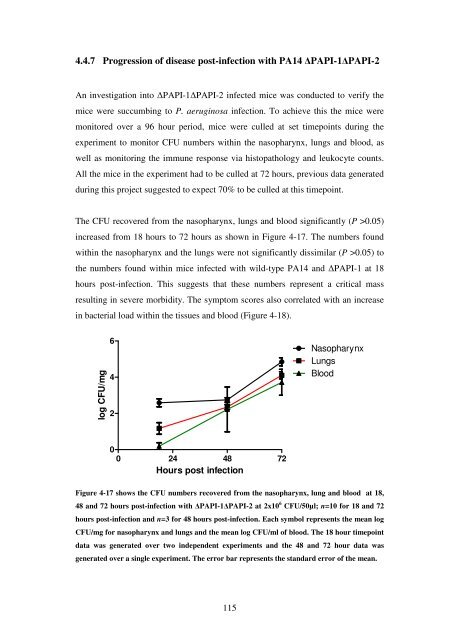5 The role of quorum-sensing in the virulence of Pseudomonas ...
5 The role of quorum-sensing in the virulence of Pseudomonas ...
5 The role of quorum-sensing in the virulence of Pseudomonas ...
You also want an ePaper? Increase the reach of your titles
YUMPU automatically turns print PDFs into web optimized ePapers that Google loves.
4.4.7 Progression <strong>of</strong> disease post-<strong>in</strong>fection with PA14 ∆PAPI-1∆PAPI-2<br />
An <strong>in</strong>vestigation <strong>in</strong>to ∆PAPI-1∆PAPI-2 <strong>in</strong>fected mice was conducted to verify <strong>the</strong><br />
mice were succumb<strong>in</strong>g to P. aerug<strong>in</strong>osa <strong>in</strong>fection. To achieve this <strong>the</strong> mice were<br />
monitored over a 96 hour period, mice were culled at set timepo<strong>in</strong>ts dur<strong>in</strong>g <strong>the</strong><br />
experiment to monitor CFU numbers with<strong>in</strong> <strong>the</strong> nasopharynx, lungs and blood, as<br />
well as monitor<strong>in</strong>g <strong>the</strong> immune response via histopathology and leukocyte counts.<br />
All <strong>the</strong> mice <strong>in</strong> <strong>the</strong> experiment had to be culled at 72 hours, previous data generated<br />
dur<strong>in</strong>g this project suggested to expect 70% to be culled at this timepo<strong>in</strong>t.<br />
<strong>The</strong> CFU recovered from <strong>the</strong> nasopharynx, lungs and blood significantly (P >0.05)<br />
<strong>in</strong>creased from 18 hours to 72 hours as shown <strong>in</strong> Figure 4-17. <strong>The</strong> numbers found<br />
with<strong>in</strong> <strong>the</strong> nasopharynx and <strong>the</strong> lungs were not significantly dissimilar (P >0.05) to<br />
<strong>the</strong> numbers found with<strong>in</strong> mice <strong>in</strong>fected with wild-type PA14 and ∆PAPI-1 at 18<br />
hours post-<strong>in</strong>fection. This suggests that <strong>the</strong>se numbers represent a critical mass<br />
result<strong>in</strong>g <strong>in</strong> severe morbidity. <strong>The</strong> symptom scores also correlated with an <strong>in</strong>crease<br />
<strong>in</strong> bacterial load with<strong>in</strong> <strong>the</strong> tissues and blood (Figure 4-18).<br />
log CFU/mg<br />
6<br />
4<br />
2<br />
0<br />
0 24 48 72<br />
Hours post <strong>in</strong>fection<br />
115<br />
Nasopharynx<br />
Lungs<br />
Blood<br />
Figure 4-17 shows <strong>the</strong> CFU numbers recovered from <strong>the</strong> nasopharynx, lung and blood at 18,<br />
48 and 72 hours post-<strong>in</strong>fection with ∆PAPI-1∆PAPI-2 at 2x10 6 CFU/50µl; n=10 for 18 and 72<br />
hours post-<strong>in</strong>fection and n=3 for 48 hours post-<strong>in</strong>fection. Each symbol represents <strong>the</strong> mean log<br />
CFU/mg for nasopharynx and lungs and <strong>the</strong> mean log CFU/ml <strong>of</strong> blood. <strong>The</strong> 18 hour timepo<strong>in</strong>t<br />
data was generated over two <strong>in</strong>dependent experiments and <strong>the</strong> 48 and 72 hour data was<br />
generated over a s<strong>in</strong>gle experiment. <strong>The</strong> error bar represents <strong>the</strong> standard error <strong>of</strong> <strong>the</strong> mean.














